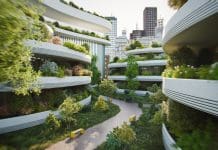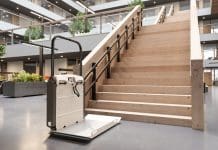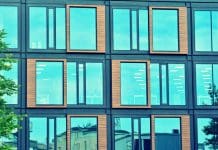How do we put the conversation around neurodiversity-friendly design into practice? Magdalena Arent, building performance consultant at Holmes Miller, says architects must drive good design and ensure the built environment is more accommodating and welcoming to neurodivergent individuals
A disability is a challenge or condition, either physical or mental, that makes it more difficult for someone to participate fully in the world around them. And since that world is full of buildings, how they are designed has a huge influence on just how difficult that can be.
While it’s mandatory that every new or refurbished building in the UK must be designed to be accessible to those with physical disabilities, there’s a growing group of people whose needs can still be overlooked.
The term “neurodivergent” encompasses a very broad group of individuals, including those with learning disabilities or conditions such as autism, dyslexia, dyspraxia and ADHD.
Society in general is becoming more aware that we don’t all think in the same way – and that those differences are not a bad thing. What’s more, with an estimated one in five people being neurodivergent, the chances are that someone you love is affected. But despite how common it is, neurodiversity is still widely misunderstood, and many people still go undiagnosed.
Being neurodivergent means your brain processes information in an atypical way, so you may react to stimuli and sensory information very differently to someone with a neurotypical brain. Many of our busy urban environments and public buildings can cause sensory overload, which can affect heart rate, breathing, blood pressure and cause significant anxiety and distress for neurodivergent people.
Neurodiversity-friendly design principles
Architects can be the drivers of neurodiversity-friendly design that makes our built environment more inclusive, accommodating and welcoming to individuals living with neurological differences. Guidance on designing for neurodiversity was published by BSI in 2022, but unlike the standards for physical accessibility, it’s not mandatory.
So when we were developing our refreshed sustainability charter at Holmes Miller, we decided we wanted to upskill the whole team in neurodiversity-friendly design principles to ensure we were designing inclusive spaces. We also wanted to be able to guide our clients in the right direction.
A building’s signage, acoustics, lighting, decor, odour, thermal comfort, familiarity and layout can all be the difference between a comfortable environment and a triggering one. A well-designed building considers all those sensory elements and strives to create an accommodating space, ensuring that people with processing differences can enjoy their experience of that environment.
The neurodiversity-friendly design challenge
The challenge is neurodiversity is exactly what it says on the tin – diverse. Like all humans, no two neurodiverse people are the same. Triggers can vary from person to person, but also from one environment to another.
Take an airport, for example. An already overwhelming and stressful environment for many of us, this can be significantly heightened for neurodiverse people. Clear signage and wayfinding, together with dedicated quiet, restorative spaces, where people can escape to if their senses are overwhelmed, can play a vital role in helping to minimise anxiety and stress.
It’s particularly important for education buildings to be designed to support neurodiversity, as it’s essential all children have access to an environment that helps them fulfil their potential. Places where people go to learn should always have additional quiet zones to allow students to take time away from a busy, overstimulating environment to help them wind down. Connecting to nature through outdoor views, natural daylight and indoor biophilic features can also help reduce anxiety.
Similarly, offices should ideally provide quiet spaces to work. Because a neurodivergent condition may be considered a disability under the Equality Act 2010, many neurodivergent employees are protected in law against discrimination and employers are obliged to make reasonable adjustments to support them at work. Designing for occupant control can be a good way to do this, as it gives users the ability to adjust the lighting, temperature and personal boundaries to something they feel comfortable with.
Providing a variety of spaces to work, from calm and quiet to inspiring and stimulating, can also increase productivity among neurotypical people. That’s the great thing about designing spaces that work for neurodivergent people – they’re almost always better for everyone else, too.
An example is our Allander Leisure Centre project in East Dunbartonshire, which incorporates a centre for adults with learning challenges, dementia and autism. It has an interior design scheme that uses colour signifiers and tactile surfaces to help with wayfinding. The inclusion of sensory and production garden areas ensures users benefit from a holistic experience that caters to their needs. The overall result is a warm, welcoming building that breaks down barriers and improves lives.
Another good example of this is the Museum of London. It’s fully accessible and hosts quiet sessions every week to allow neurodiverse people to explore the galleries in a quieter environment. But what is particularly impressive is the museum’s sensory map. This identifies areas guests may want to steer clear of if they dislike it being too bright, dark, loud, busy, quiet or smelly. This helps visitors avoid discomfort or anxiety during their visit.
While we know it’s impossible to meet the individual needs of every person, our main goal when creating neurodiversity-friendly design is to avoid sensory overload and ensure more people can feel comfortable in shared spaces. Put simply, it’s about making orientation easier, providing calming places to escape to, and offering building users more choice and control over their sensory environment.
And let’s face it – who wouldn’t benefit from that?

Magdalena Arent
Building performance consultant
Holmes Miller





![[VIDEO] UK-based firm reveals ‘world’s first’ fully AI-driven architectural project Studio Tim Fu has revealed the 'world's first' fully AI-driven architectural project in Slovenia, developing six luxury villas on the Lake Bled Estate](https://www.pbctoday.co.uk/news/wp-content/uploads/2025/03/Interior-1-studio-tim-fu-218x150.gif)








